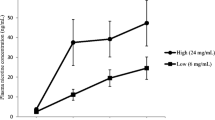Abstract
Fifteen subjects participated in a randomised, placebo-controlled cross-over study to assess the effect of a nicotine vapour inhaler on craving and other withdrawal symptoms during a two-day smoking-free period. Craving and withdrawal symptoms were rated nine times over the two-day period on 10 cm visual analogue scales. Plasma nicotine concentrations in the afternoon of each study day were determined. The results show that active treatment was significantly superior to placebo in decreasing craving and other withdrawal symptom scores. No difference was found between two inhalation techniques, one with shallow, frequent inhalations (buccal technique), and the other with deep inhalations (pulmonary technique). The average number of active nicotine vapour inhalers and placebo inhalers used during the two-day sessions was 12 and 11, respectively. Afternoon plasma nicotine levels of approximately 7 ng/ml were obtained with both inhalation techniques. A strong correlation was found between the afternoon plasma nicotine levels and craving, a high nicotine level being associated with a low craving score. The study has provided information about how to use the nicotine vapour inhaler that could have important implications if it were to be approved for the treatment of tobacco dependence. The use of withdrawal symptom reduction as a surrogate endpoint is discussed.
Similar content being viewed by others
References
Bergström M, Nordberg A, Lunell E, Antoni G, L»ngström B (1995) Regional deposition of inhaled 11C-nicotine vapour in the human airways as visualized by Positron Emission Tomography (PET). Clin Pharmacol Ther 57:309–317
Fagerström KO, Schneider NG (1989) Measuring nicotine dependence: A review of the Fagerstrom Tolerance Questionnaire. J Behav Med 12: 159–181
Fagerström KO, Schneider NG, Lunell E (1993) Effectiveness of nicotine patch and nicotine gum as individual versus combined treatments for tobacco withdrawal symptoms. Psychopharmacology 111: 271–277
Hajek P, West RJ, Belcher M (1989) Severity of withdrawal symptoms as a predictor of outcome of an attempt to quit smoking. Psychol Med 19: 981–985
Henningfield JE, Keenan RM (1993) Nicotine delivery kinetics and abuse liability. J Consult Clin Psychol 61: 743–750
Hughes JR, Hatsukami DK (1986) Signs and symptoms of tobacco withdrawal. Arch Gen Psychiat 43: 289–294
Hughes JR, Higgins ST, Hatsukami DK (1990) Effects of abstinence from tobacco: a critical review. In: Kozlowski LT, Annis H, Cappell HD, Glaser F, Goodstadt M, Israel Y, Kalant H, Sellers EM, Vingilis J (eds) Research advances in alcohol and drug problems, vol 10 Plenum Pres, New York pp 317–398
Hughes JR, Gust SW, Skoog K, Keenan RM, Fenwick JW (1991) Symptoms of tobacco withdrawal. Arch Gen Psychiat 48: 52–59
Jarvis MJ, Russel MAH, Saloojee Y (1980) Expired air carbon monoxide: a simple breath test of tobacco smoke intake. BMJ 281: 484–485
Killen JD, Fortman SP, Newman B, Varady A (1991) Prospective study of factors influencing the development of craving associated with smoking cessation. Psychopharmacology 105: 191–196
Olsson P, Kuylenstierna F, Johansson C-J, Gunnar PO, Bende M (1991) Pharmacokinetics of nicotine after intranasal administration. In: Adlkofer F (ed) Effects of nicotine on biological systems. Advances in pharmacological sciences Birkhäuser, Basel, pp 57–61
Rose JE, Levin ED (1991) Inter-relationships between conditioned and primary reinforcement in the maintenance of cigarette smoking. Br J Addiction 86: 605–609
Russell MAH, Jarvis MJ, Sutherland G, Feyerabend C (1987) Nicotine replacement in smoking cessation: Absorption of nicotine vapor from smoke-free cigarettes. JAMA 257; 23: 3262–3265
Schneider NG (1992) Nicotine therapy in smoking cessation. Pharmacokinetic considerations. Clin Pharmacokinet 23: 169–172
Schneider NG, Jarvik ME (1984) Time course of smoking withdrawal symptoms as a function of nicotine replacement. Psychopharmacology 82: 143–144
Tønnesen P, Nørregaard J, Mikkelsen K, Jørgensen S, Nilsson F (1993) A double-blind trial of nicotine inhaler for smoking cessation. JAMA 269: 1268–1271
Author information
Authors and Affiliations
Rights and permissions
About this article
Cite this article
Lunell, E., Molander, L., Fagerström, K.O. et al. Effect of nicotine vapour inhalation on the relief of tobacco withdrawal symptoms. Eur J Clin Pharmacol 48, 235–240 (1995). https://doi.org/10.1007/BF00198304
Received:
Accepted:
Issue Date:
DOI: https://doi.org/10.1007/BF00198304




